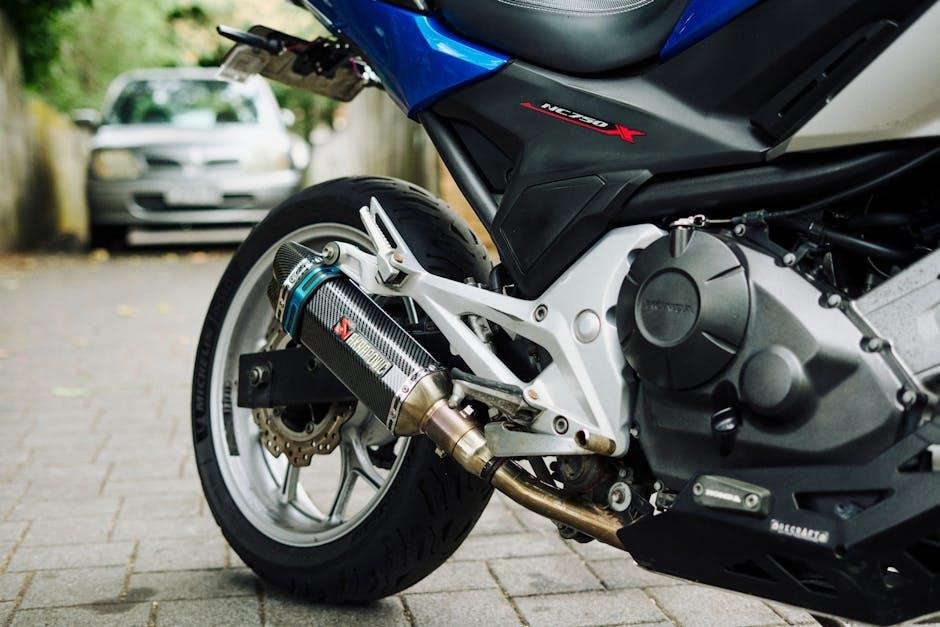The 2011 Honda Pilot User Manual is a comprehensive guide designed to help owners understand and maintain their vehicle effectively. It covers key features, safety precautions, and maintenance schedules, ensuring optimal performance and longevity of the vehicle. This manual is an essential resource for anyone who wants to get the most out of their Honda Pilot.
Purpose and Importance of the User Manual
The 2011 Honda Pilot User Manual serves as an essential guide for owners to understand their vehicle’s features, safety measures, and maintenance requirements. It provides detailed instructions for optimal performance, troubleshooting, and proper care. By following the manual, drivers can ensure safety, prevent potential damage, and maintain their vehicle’s longevity. It is a vital resource for addressing questions, resolving issues, and enhancing the overall ownership experience for both new and experienced drivers.

Key Features of the 2011 Honda Pilot
The 2011 Honda Pilot boasts a powerful 3.5L V6 engine, versatile seating for up to eight passengers, and advanced all-wheel-drive capability. Its robust design combines practicality with comfort, making it ideal for families and outdoor enthusiasts alike. Key features include a spacious interior, ample cargo space, and innovative technology options, ensuring a smooth and enjoyable driving experience.
Controls and Instrumentation
The 2011 Honda Pilot features an intuitive control layout, with a central instrument panel displaying essential gauges like speed, RPM, and fuel level. The steering wheel includes controls for audio and cruise settings, while the gearshift and parking brake are ergonomically positioned. Additional controls for climate, navigation, and entertainment are accessible via buttons and knobs on the dashboard. This design ensures easy operation and minimizes driver distraction, promoting a safe and efficient driving experience.
Safety Features and Precautions
The 2011 Honda Pilot prioritizes safety with features like a multi-angle rearview camera and Advanced Compatibility Engineering (ACE) body structure for enhanced collision protection. Drivers are advised to always wear seatbelts, ensure proper child seat installation, and avoid distractions while driving. Regular maintenance of brakes, tires, and suspension is crucial for safety. The manual emphasizes adherence to recommended guidelines to ensure the vehicle operates safely and efficiently under all conditions.
Maintenance and Service Schedule
Regular maintenance is crucial for the longevity and performance of your 2011 Honda Pilot. The manual outlines a detailed service schedule, including oil changes every 5,000 to 7,500 miles, tire pressure checks, and fluid replacements. It also recommends inspecting brakes, belts, and air filters at specific intervals. Adhering to this schedule ensures optimal vehicle performance, prevents potential issues, and maintains reliability over time. Proper maintenance habits are essential for preserving the health and efficiency of your Honda Pilot.

Troubleshooting and Diagnostic Procedures
This section provides diagnostic tools and procedures to help identify and resolve issues. Step-by-step guidance ensures efficient and effective troubleshooting for optimal vehicle performance.
Common Issues and Solutions
Common issues with the 2011 Honda Pilot include blown fuses, transmission slipping, and air conditioning malfunctions. Solutions involve checking fuse boxes, inspecting transmission fluid levels, and ensuring proper refrigerant levels. Regular maintenance, such as oil changes and tire rotations, can prevent many problems. Addressing these issues promptly ensures reliability and extends the vehicle’s lifespan.
Understanding Diagnostic Codes
The 2011 Honda Pilot User Manual provides guidance on interpreting diagnostic trouble codes (DTCs) for effective troubleshooting. These codes, generated by the vehicle’s onboard computer, help identify issues like engine misfires or system malfunctions. Using an OBD-II scanner, owners can retrieve codes and refer to the manual for explanations. Common codes include P0300 (random cylinder misfire) and P0171 (system too lean). The manual offers step-by-step solutions, ensuring proper diagnosis and repair to maintain optimal vehicle performance and safety.

Technical Specifications of the 2011 Honda Pilot
The 2011 Honda Pilot features a 3.5L V6 engine, offering a blend of power and efficiency. It is a mid-size SUV designed for versatility and reliability, with a robust design and spacious interior, making it ideal for both family use and outdoor adventures. The vehicle runs on gasoline and is known for its durability and practicality, making it a popular choice among drivers seeking a dependable ride.
Engine and Performance Details
The 2011 Honda Pilot is equipped with a powerful 3.5L V6 engine, delivering smooth performance and reliability. It features a single overhead camshaft (SOHC) design with fuel injection. The engine produces 250 HP at 5,700 RPM and 253 lb-ft of torque at 4,800 RPM. The vehicle runs on regular unleaded fuel, offering a balance of power and efficiency. Available in both front-wheel drive (FWD) and all-wheel drive (AWD), the Pilot provides versatility for various driving conditions. Its towing capacity of up to 4,500 pounds adds to its practicality, making it a capable choice for both daily driving and outdoor adventures.
Transmission and Fuel Efficiency
The 2011 Honda Pilot features a 5-speed automatic transmission, designed for smooth shifting and optimal performance. Front-wheel drive (FWD) models achieve an EPA-estimated 17 MPG city and 23 MPG highway, while all-wheel drive (AWD) models offer 17 MPG city and 22 MPG highway. The Pilot balances power and efficiency, making it suitable for both urban and rural driving. Proper maintenance, as outlined in the manual, ensures these fuel efficiency ratings are maintained.

Safety Features and Emergency Procedures
The 2011 Honda Pilot is equipped with advanced safety features, including a multi-angle rearview camera and ACE™ body structure. In emergencies, follow proper collision response and roadside assistance procedures outlined in the manual to ensure passenger safety and vehicle preservation.
Airbag System and Collision Safety
The 2011 Honda Pilot features an advanced airbag system, including dual front, side, and side curtain airbags, designed to enhance occupant protection in collisions. The ACE™ body structure absorbs and distributes crash energy to minimize impact. Always ensure proper use of seatbelts, as airbags are supplementary. After a collision, inspect the system and follow manual guidelines for resetting or servicing. Never modify or disable the airbag system, as it compromises safety.
Emergency Response and Roadside Assistance
In case of an emergency, the 2011 Honda Pilot is equipped with features to help ensure safety. Familiarize yourself with the emergency response guide in the manual, which includes procedures for accidents, breakdowns, and proper use of the spare tire and jack. Always keep an emergency kit in the vehicle. For roadside assistance, contact Honda Roadside Assistance for towing and support services. Preparation is key to handling unexpected situations effectively and safely.
Accessories and Customization Options
The 2011 Honda Pilot offers a variety of accessories to enhance functionality and style. From roof racks to cargo organizers, these options allow owners to customize their vehicle to suit their needs. Genuine Honda accessories ensure compatibility and quality, providing a seamless integration with the vehicle’s design and performance. Explore the range of available accessories to personalize your Honda Pilot for ultimate convenience and satisfaction.
Available Accessories for the 2011 Honda Pilot
The 2011 Honda Pilot offers a wide range of accessories to enhance its functionality and style. These include roof racks for added storage, cargo organizers for better trunk space management, and fender flares for a rugged look. Additionally, interior accessories like premium floor mats and cargo trays protect the vehicle’s interior while maintaining its aesthetic appeal. All genuine Honda accessories are designed to fit perfectly, ensuring durability and compatibility with the Pilot’s design and performance.
Installation and Compatibility Guidelines
When installing accessories or performing maintenance on your 2011 Honda Pilot, always follow the guidelines outlined in the user manual. Ensure all parts are compatible with your vehicle’s specifications. Use genuine Honda accessories to maintain performance and safety. Refer to the manual for step-by-step installation instructions and torque specifications. Proper installation tools and techniques are crucial to avoid damage. For complex installations, consult a professional to ensure everything functions correctly and safely.

DIY Maintenance and Repair Guides
The 2011 Honda Pilot User Manual empowers owners with detailed DIY guides for basic maintenance and repairs. From oil changes to filter replacements, it ensures safety and efficiency, helping you keep your vehicle in top condition with minimal effort and cost. Always refer to the manual for specific instructions and precautions to avoid complications.
Basic Maintenance Tasks
The 2011 Honda Pilot User Manual outlines essential maintenance tasks to ensure optimal vehicle performance. Regular oil changes, tire pressure checks, and fluid level inspections are emphasized. Replacing air filters and checking battery health are also highlighted. These simple tasks help prevent major issues and extend the vehicle’s lifespan. The manual provides clear instructions and recommended intervals for each task, making it easy for owners to maintain their vehicle effectively and safely.
Advanced Repair Procedures
The 2011 Honda Pilot User Manual provides detailed guidance for advanced repair procedures, such as transmission flushes and timing belt replacements. It emphasizes the importance of using genuine Honda parts and specialized tools for these tasks. Diagnostic code analysis and complex system troubleshooting are also covered, ensuring owners can address issues confidently. Always consult the manual before attempting repairs to ensure safety and proper execution of procedures.
Comparison with Other Honda Pilot Models
The 2011 Honda Pilot offers enhanced fuel efficiency and improved interior features compared to earlier models, making it a standout choice in its class for practicality and performance.
Upgrades and Improvements Over Previous Models
The 2011 Honda Pilot features several upgrades, including a refined V6 engine for better fuel efficiency and smoother performance. The interior boasts enhanced comfort with improved seating materials and updated technology. Safety has also been bolstered with additional airbags and advanced stability control systems. These improvements make the 2011 model a more reliable and enjoyable choice compared to earlier versions, addressing user feedback and industry standards effectively.

Differences in Features and Performance
The 2011 Honda Pilot distinguishes itself with a powerful 3.5L V6 engine, delivering 250 horsepower and improved torque. It offers a smoother Variable Cylinder Management system, enhancing fuel efficiency. The interior features a more spacious design with third-row seating and versatile cargo options. Advanced technology includes a rearview camera and an updated audio system. These enhancements provide a balanced blend of power, comfort, and practicality, setting the 2011 model apart in its class with refined performance and modern amenities.

Digital Versions and Online Resources
Digital versions of the 2011 Honda Pilot User Manual are available online, offering convenient access and easy navigation. Additional resources include downloadable guides and support materials.
Downloading the User Manual
Downloading the 2011 Honda Pilot User Manual is straightforward. Visit official Honda websites or trusted third-party platforms to access the PDF version. Ensure compatibility with your device for easy viewing. Registration may be required on some sites. The manual is available free of charge, offering convenient access to essential information. This digital format allows users to search, bookmark, and print specific sections as needed, enhancing usability and accessibility for owners seeking guidance on their vehicle’s operation and maintenance.
Additional Online Resources and Support
Beyond the 2011 Honda Pilot User Manual, owners can access various online resources for enhanced support. Official Honda websites, forums, and YouTube tutorials provide detailed guides and troubleshooting tips. Additionally, online marketplaces offer genuine parts and accessories, ensuring compatibility and quality. Many communities and forums dedicated to Honda Pilot owners share experiences and solutions, fostering a supportive environment for resolving issues and optimizing vehicle performance. These resources complement the manual, offering a holistic approach to ownership and maintenance.
The 2011 Honda Pilot User Manual is an indispensable tool for owners seeking to maximize their vehicle’s performance and longevity. Regular maintenance, adherence to safety guidelines, and proper use of features are key to a satisfying ownership experience. Always refer to the manual for guidance, and consider keeping a digital copy for easy access. By following the recommendations, you’ll ensure your Honda Pilot remains reliable and efficient for years to come. Safe driving and happy adventures!
